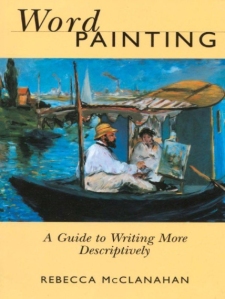 Some of us try to use description language too much in our writing and others need to start thinking about how to use this literary tool more often.
Some of us try to use description language too much in our writing and others need to start thinking about how to use this literary tool more often.
The dictionary defines “describe” as:
To transmit a mental image or impression
To trace or draw the figure of; to outline
To give a verbal account of; to tell about in detail
Used properly it can take your reader into your fictional dream and that is a good thing.
I just bought Word Painting by Rebecca Mcclanahan and thought I would share some of the things she talks about in the first chapter that should give you food for thought. Like I said I just bought it, but so far I am glad I added it to my “How to” books.
1. Descriptive passages create the illusion of reality, inviting the reader to move in, unpack, and move in for a spell. They provide verisimilitude. What John Gardner (author of The Art of Fiction) calls the “proofs” that support and sustain your fictional dream. It is not a bunch of “flowery stuff.” It is not just something we stitch on top of our writing to make it more presentable.
2. Description composed of sensory detail penetrates layers of consciousness, engaging your reader emotionally as well as intellectually. The success of all fiction depends in part on descriptive image-making power.
3. Carefully selected descriptive details can establish you characters and setting quickly and efficiently. It is not merely describing how something looks with visual detail, but also smells, tastes, textures, and sounds.
4. As a framing device, description establishes the narrator’s, or character’s point of view. Shifts in the description frame (or eye) can signal shifts in point of view or a significant change in the character. Description begins in the eye, ear, mouth, nose, and hand of the beholder. Careful and imaginative observation may well be the most essential task of any writer.
5. Well-placed descriptive passages can move your story along, shape the narrative line and unfold the plot. It is not a way to hide from the truth. The world isn’t always pretty. Describe it honestly and face difficult, even ugly, subjects when necessary.
6. Descriptive passages can act as gearshifts, changing the pace of your story – speeding it up or slowing it down, then increasing the story’s tension.
7. Description can serve as a transitional device, a way of linking scene or changing time and place.
8. Description can orchestrate the dance between scene and summary.
9. Description can serve as a unifying thematic device, what Stanley Kunitz calls the “constellation of images” that appears and reappears in a literary work, suggesting the idea or feeling that lives beneath the story line.
10. Description can provide the palette of gradations in mood and tone. Dip you brush in one description and the darkens; in another, and the sun breaks through.
11. The language of you descriptions, its rhythms and sounds, can provide the equivalent of a muscial score for the fictional dream, a subliminal music that plays beneath the story line.
12. Writing descriptively doesn’t always mean writing gracefully. It won’t necessarily make our writing more refine, lyrical, or poetic. Some descriptions demand uneven syntax and plainspoken, blunt prose. Jagged, even. Fragments, too. Slice of chin. Buzz saw.
13. Description doesn’t always require a bigger vocabulary. House is probably a better choice than domicile, a horse is easier to visualize than an equine mammal, and red blood is brighter than the sanguine flow of bodily fluids.
14. Writing descriptively doesn’t necessitate writing more. Description isn’t a steroid, something to make our language bigger and stronger, nor is it an additive promising more miles to the fictional gallon. Sometimes writing descriptively means writing less or disappear altogether.
15. Description rarely stands alone. It should be woven in and seamlessly intertwined with other literary elements. Description isn’t something we simply insert, block style, into passages of narration or exposition. Yes, sometimes we write passages of description. But the term passage suggests a channel, a movement from one place to another; it implies that we’re going somewhere. That somewhere is the story.
Hope this helps.
Talk tomorrow,
Kathy
Thanks for sharing! Very insightful.
LikeLike
By: Sharalyn Edgeberg on March 11, 2014
at 10:53 am
Terrific stuff. Unfortunately, I often find a lot of description seems forced – like bad rhyme!
LikeLike
By: julie rowan zoch on March 11, 2014
at 1:18 pm
Good post. Just shared with my writing students! Thanks.
LikeLike
By: Carol Federlin Baldwin on March 11, 2014
at 9:19 pm
Thanks for this post. It’s wonderful. I didn’t know this book, but just ordered a copy after reading this.
LikeLike
By: Rosi Hollinbeck on March 12, 2014
at 1:32 am
Reblogged this on Flynn Gray and commented:
I find it difficult to write description without getting bogged down in too much detail and slowing the pace of the story. Description is essential, however, and this post provides some great tips for descriptive writing. ~ Flynn
LikeLike
By: Flynn Gray on October 5, 2015
at 12:23 am